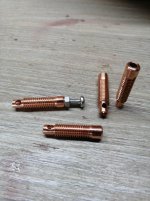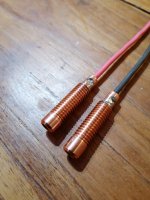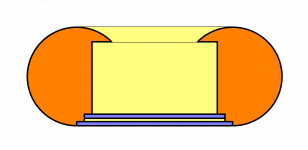It would be nice to be able to get some measurements. The one I would most like to get a handle on is baffle step. Most projects that use the eikona don't use any compensation. I'm hoping that I won't need to either. If it sounds like the bottom end is a bit thin then I will probably add compensation actively at a later date when funds allow.
Niffy
Niffy
Gorgeous.
By the way... How are you planning to support these?
They'll need some elegant stands.
I have a plan for the stands. Unlike a box speaker I won't have a nice flat base to stand them on so I have to be creative. I personally like tall stands that place the driver slightly above ear level with the speakers angled down. I find that this helps to portray a more realistic sense of scale. I think that my plan will look good. Watch this space.
Niffy
niffy,
The cabinets are looking gorgeous. Take your time, don't rush, and finish the job in style! 🙂
The cabinets are looking gorgeous. Take your time, don't rush, and finish the job in style! 🙂
If you are building a sealed box with a full range driver measurements are not so important. I decided that I would spend my entire budget on the best possible drivers rather than splitting it between drivers and measurement equipment.
Niffy
Hmmmm... I wonder why we have drivers specs if measurements are not important.
Others have huge threads full of measurements, trying to achieve the best sound possible, and not relying on luck.
Sorry, but I don't understand that, in 2020, someone who is involved in designing something so unique and spending a long time on design and manufacture of said design, doesn't have $100 on a measurement mic.
Full range never meant perfect. The fact that you don't have a crossover doesn't mean that the driver will have a very nice frequency curve right off the bat.
Do yourself a favor for this great project... get a mic. They're quite cheap these days.
Measure, take the guessing out of the equation.
Hi Perceval,
When building a multiway, especially one with a crossover in the critical midrange, driver specs and measurements are important/essential.
With a full range driver specs are still of great value, especially the ts parameters as these determine cabinet volume. Also, is the driver really full range and is it likely to have any nasty break up peeks. Probably not a problem with the eikona.
I have based my cabinet on Jordan's published specs. If the sound of the speakers I'm building isn't right there is little, apart from adjusting the filling that can be done mechanically. As most builds that use the eikona don't employ any correction I'm hoping to not need any either. With my existing speakers I have employed both baffle step and a roll off of the bottom end passively. If I find that I need either of these then I am hoping to implement them actively. If I like the sound of the speakers without sticking anything in the line the cost of a microphone (and a better sound card) would be wasted.
Will sticking more electronics in the line, electronics that will inevitably change the phase as well as the levels, do more harm than good, very likely.
Of course I would love to have a decent measurement system, just for curiosity sake. Including one in the budget before it is known if I need one is not prudent.
Niffy
When building a multiway, especially one with a crossover in the critical midrange, driver specs and measurements are important/essential.
With a full range driver specs are still of great value, especially the ts parameters as these determine cabinet volume. Also, is the driver really full range and is it likely to have any nasty break up peeks. Probably not a problem with the eikona.
I have based my cabinet on Jordan's published specs. If the sound of the speakers I'm building isn't right there is little, apart from adjusting the filling that can be done mechanically. As most builds that use the eikona don't employ any correction I'm hoping to not need any either. With my existing speakers I have employed both baffle step and a roll off of the bottom end passively. If I find that I need either of these then I am hoping to implement them actively. If I like the sound of the speakers without sticking anything in the line the cost of a microphone (and a better sound card) would be wasted.
Will sticking more electronics in the line, electronics that will inevitably change the phase as well as the levels, do more harm than good, very likely.
Of course I would love to have a decent measurement system, just for curiosity sake. Including one in the budget before it is known if I need one is not prudent.
Niffy
To each his/her own.
Just like I wouldn't build a wall in my house without a level, I wouldn't build speakers without a mic, and even something to corroborate the driver's manufacturer's specs, which I've seen from some companies to be ... let's just say, enthusiastic.
Hoping that Jordan is better than others! 🙂
Just like I wouldn't build a wall in my house without a level, I wouldn't build speakers without a mic, and even something to corroborate the driver's manufacturer's specs, which I've seen from some companies to be ... let's just say, enthusiastic.
Hoping that Jordan is better than others! 🙂
My point is that I have a total budget of about £750. I don't have a microphone. I don't have a microphone stand or any of the required cables. I don't use my computer for sound, I don't even have speakers attached to it. I would definitely need to fit a sound card. At least I could use free software. To purchase all of this would eat a sizeable chunk of my budget, probably the best part of £200. If I'm still spending £200 on the cabinets etc then my budget for drive units will have to be slashed. My research suggests that the Jordans are the best full range drivers within my budget.
Is a measurement system going to allow me to get a better sound using much lower quality drivers? I very much doubt it. Don't forget that modifying the sound of the speaker is going to require a filter network of some variety. The cost of this filter, and an enclosure for it, also has to come out of the budget further reducing the quality of drivers available to me.
I have chosen to trust the Jordan specifications and all the other people who have successfully used these drivers without any filters.
I believe that this approach is the most likely to yield the best results.
Build a wall out of pine with a level or out of oak without one?
It seems obvious to me that I should build the best speakers that I can for the budget. If, as I expect, they sound great straight out of the gate then I won't have wasted money on a measurement system that doesn't add anything.
There is also nothing to stop me from purchasing a measurement system and building a filter (probably active) at a later date, if I feel that it is needed.
Niffy
Is a measurement system going to allow me to get a better sound using much lower quality drivers? I very much doubt it. Don't forget that modifying the sound of the speaker is going to require a filter network of some variety. The cost of this filter, and an enclosure for it, also has to come out of the budget further reducing the quality of drivers available to me.
I have chosen to trust the Jordan specifications and all the other people who have successfully used these drivers without any filters.
I believe that this approach is the most likely to yield the best results.
Build a wall out of pine with a level or out of oak without one?
It seems obvious to me that I should build the best speakers that I can for the budget. If, as I expect, they sound great straight out of the gate then I won't have wasted money on a measurement system that doesn't add anything.
There is also nothing to stop me from purchasing a measurement system and building a filter (probably active) at a later date, if I feel that it is needed.
Niffy
I don't have a PC so I would have to buy one of those too and that's a learning curve I can't be bothered with. I don't see why one can't get a good idea of the frequency response of a speaker by listening to sweeps, that would show up anything bad enough to cause poor sound or listening fatigue surely?
Even better than sweeps. Music.
My current speakers were built with the aid of measurements but the final tweeking was done by ear. Without the use of measurements I would not have been able to make the crossover as benign as I have. Getting rid of the crossover gets rid of most of need for measuring.
If there is a problem measuring can help to isolate it better than ears alone.
See (hear) if there is a problem before spending loads of money on trying to fix it.
Niffy
My current speakers were built with the aid of measurements but the final tweeking was done by ear. Without the use of measurements I would not have been able to make the crossover as benign as I have. Getting rid of the crossover gets rid of most of need for measuring.
If there is a problem measuring can help to isolate it better than ears alone.
See (hear) if there is a problem before spending loads of money on trying to fix it.
Niffy
Even better than sweeps. Music.
I haven't got perfect pitch 😉 and needed to know the frequency when I tried EQing. I only founded EQ marginally useful when my speakers were too close to the room corners and I was getting a resonance around 200Hz. Now I don't use any and listen nearfield, they are also crossed over to subs which are positioned and EQ'd separately to suit the room and my listening position.
This seems to be the general consensus with Jordans. Run the Jordans direct from the power amp with no equalisation. The only crossover or equalisation is applied to the sub if one is used.
Niffy
Niffy
Niffy.
I think if you've made the decision to go "full" then keeping a light touch with the tweaks is appropriate.
On the topic of compensation networks here's Nelson Pass's discussion of full range drivers and current amps and the networks he found to work best, the Jordan J92S included... just for reference (see pages 7 and 22).
http://www.firstwatt.com/pdf/art_cs_amps.pdf
With respect to the ability of Jordan to build closely to spec (and therefore present no unpleasant surprises to those relying on published data), I found that Colin at Jordan is a helpful resource for questions I've had. He has been known to peruse these boards too.
I think if you've made the decision to go "full" then keeping a light touch with the tweaks is appropriate.
On the topic of compensation networks here's Nelson Pass's discussion of full range drivers and current amps and the networks he found to work best, the Jordan J92S included... just for reference (see pages 7 and 22).
http://www.firstwatt.com/pdf/art_cs_amps.pdf
With respect to the ability of Jordan to build closely to spec (and therefore present no unpleasant surprises to those relying on published data), I found that Colin at Jordan is a helpful resource for questions I've had. He has been known to peruse these boards too.
Thanks mhenschel,
I'll give the article a good read when I get a chance. Nelson always has an interesting take on things.
Niffy
I'll give the article a good read when I get a chance. Nelson always has an interesting take on things.
Niffy
AFAIK the cones are made in the UK, it would be interesting to know by who, then sent to Scan-Speak who make the speakers.
Not spherical, not elongated, but almost torus
The spherical enclosure becomes pretty if the grills match the shape, which seems to be what Gradient achieved. But I am not sure whether the enclosure would be otherwise optimal. I was thinking about a different shape.
Hi Nikolas,
I found this side view of the gradient speaker.
View attachment 872399
Now it makes sense. The spherical cabinet has equal sized grills front and back with an aperiodic vent the size of the driver behind the rear one. I'm guessing that the interior of the cabinet is probably spherical.
A cabinet of this shape should be easy to construct using translam. Hopefully you can find suitable grills.
The spherical enclosure becomes pretty if the grills match the shape, which seems to be what Gradient achieved. But I am not sure whether the enclosure would be otherwise optimal. I was thinking about a different shape.
Attachments
Hi mhenschel,
I've had a read through of the Nelson Pass article. There are several points that I think are very relevant to the discussion here. The Jordan driver has the smoothest frequency response, with or without filters, of any of the tested units. "it is very, very smooth and a wonderful speaker". If anything the Jordans response without the filters is better then with it.
It also has the flattest impedance. Additionally it shows the least variation between voltage and current source. This will indicate that this Jordan driver is going to be a lot more flexible with regards to partnering equipment.
This is further confirmation that Jordan is a good choice of driver and that it is probably best run with no additional filtering making the taking of measurements much less important.
Of course the article was referring to the jx92. By all accounts the eikona is similar to but better than the jx92.
Niffy
I've had a read through of the Nelson Pass article. There are several points that I think are very relevant to the discussion here. The Jordan driver has the smoothest frequency response, with or without filters, of any of the tested units. "it is very, very smooth and a wonderful speaker". If anything the Jordans response without the filters is better then with it.
It also has the flattest impedance. Additionally it shows the least variation between voltage and current source. This will indicate that this Jordan driver is going to be a lot more flexible with regards to partnering equipment.
This is further confirmation that Jordan is a good choice of driver and that it is probably best run with no additional filtering making the taking of measurements much less important.
Of course the article was referring to the jx92. By all accounts the eikona is similar to but better than the jx92.
Niffy
Sockets
In between coats of varnish I've been working on the input sockets. I want the sockets to be as unobtrusive as possible and not spoil the smooth lines of the cabinets. Traditional binding posts would be far too bulky. I decided that the best route would be 4mm sockets (for banana plugs only) flush mounted. Predictably, I couldn't find sockets like this so I made my own. The cabinet walls are about 100mm thick at the point where the sockets will be fitted so mounting from the inside will not be possible. I have made the sockets from 8mm pure copper rod. The sockets are 35mm long and externally threaded so they can be screwed into the cabinet from the outside. The last 5mm is left untreated so just a small button can be left protruding. The back of the socket is a solder bucket. Behind the 4mm socket section is a short M4 thread. This allows a bolt with locking nut to be used to drive the socket into the cabinet, and remove it again if required.
These were total pigs to make. Pure copper really snatches and binds on the tools. I now know why tellurium is added by most manufacturers of copper posts and sockets.


Niffy
In between coats of varnish I've been working on the input sockets. I want the sockets to be as unobtrusive as possible and not spoil the smooth lines of the cabinets. Traditional binding posts would be far too bulky. I decided that the best route would be 4mm sockets (for banana plugs only) flush mounted. Predictably, I couldn't find sockets like this so I made my own. The cabinet walls are about 100mm thick at the point where the sockets will be fitted so mounting from the inside will not be possible. I have made the sockets from 8mm pure copper rod. The sockets are 35mm long and externally threaded so they can be screwed into the cabinet from the outside. The last 5mm is left untreated so just a small button can be left protruding. The back of the socket is a solder bucket. Behind the 4mm socket section is a short M4 thread. This allows a bolt with locking nut to be used to drive the socket into the cabinet, and remove it again if required.
These were total pigs to make. Pure copper really snatches and binds on the tools. I now know why tellurium is added by most manufacturers of copper posts and sockets.


Niffy
Many manufacturers of binding posts and phono sockets offer unplated pure copper versions. These don't seem to suffer oxidation problems. The plugs I have purchased are a good snug fit so hopefully won't allow an oxide layer to form at the points of contact.
Niffy
Niffy
- Home
- Loudspeakers
- Full Range
- Jordan Eikona Translam Ellipsoid
